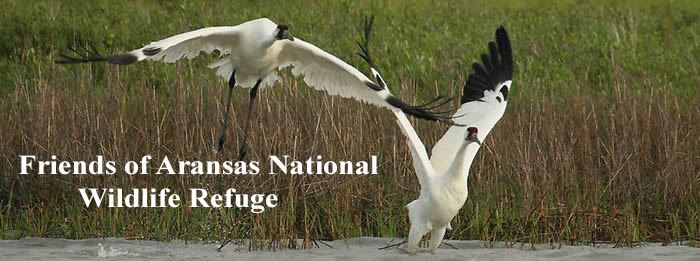Wade Harrell, U.S. Whooping Crane Recovery Coordinator
We successfully completed our annual whooping crane abundance survey last week, flying surveys on a record six consecutive days, beginning on Monday, December 8 and ending this past Saturday, December 13, 2014. Rarely do we get that many consecutive days of suitable weather for surveys, so we feel extremely fortunate that we were able to complete the 6 survey flights that our whooping crane abundance survey protocol requires. Once again, Terry Liddick, pilot/biologist from our migratory birds program, served as pilot, flying a U.S. Fish & Wildlife Service Cessna 206. Observers were Wade Harrell, Beau Beau Hardegree (Coastal Program biologist, Corpus Christi FWS office) and Diana Iriarte (Aransas NWR biologist).
· Data management and analysis once the actual survey is complete is a significant effort conducted by multiple staff members, so we won’t have the final results to present for a few months. But, I will share some general post-survey observations:
· We consistently observed whooping cranes using every unit of Aransas National Wildlife Refuge (Blackjack, Matagorda, Tatton, Lamar and Myrtle-Foester Whitmire).
· We observed larger than average group sizes (>8) of whooping cranes in several of our primary survey blocks, with these groups consistently observed in the Blackjack and Welder Flats primary survey blocks. These large groups often contained more than 1 family group.
· We consistently observed 3 family groups that included 2 juveniles (i.e. commonly referred to as “twins”).
· One pair of whooping cranes was consistently detected from each of 3 of our secondary survey areas (Holiday Beach, Powderhorn Lake (Myrtle-Foester Whitmire Unit) and Matagorda Island North)
· We detected whooping crane pairs both further south on San Jose Island (southern portion of primary survey area) and Matagorda Island (northern portion of primary survey area) than in the past few years.
· While coastal salt marsh was the most common habitat type that we observed whooping cranes using during the survey, we observed whooping cranes using a wide variety of other habitat types as well including freshwater wetlands, upland prairies and shrublands and open-water bay edges.
· Overall, habitat appeared to be in better condition than the past few years. We observed a significant amount of freshwater and green, lush vegetation in upland areas.
Several of the observations noted from last week’s survey point to an expanding whooping crane population that is exhibiting a wider range of behaviors than we have observed in the past. This “change” is to be expected as larger populations tend to have greater genetic and behavioral variability than smaller populations do. This wider range of behavior is a positive step in the long road to recovery for this endangered species, as larger populations with more behavioral and genetic variation tend to be more resilient to environmental changes than small populations. While the Aransas-Wood Buffalo population is still relatively small (about 300), it has roughly tripled in size over the last 30 years.
This year we were also able to capture some survey video footage with GoPro cameras mounted to the outside of the plane. These are wide-angle cameras that we are hoping will help us continually improve our survey methods as well as have some video of annual changes in habitat. Over the next few weeks, we will be sorting through some of the survey video and will work to share some clips in future updates.
I want to note that the annual whooping crane abundance survey is a collective effort, with the pilot and observers in the plane only serving one small role within the overall survey. I want to personally thank Greg Birkenfeld, acting Aransas NWR project leader, for serving as overall manager of the effort, Diana Iriarte, Aransas NWR biologist, for serving as our go-to data collection technology and data management specialist, Susie Perez and Josie Farias, administrative staff at Aransas NWR, for assisting with logistics and Grant Harris and Matthew Butler from our Refuge Regional Office Inventory & Monitoring Team for survey protocol development and data analysis.
We will be flying some additional training surveys in early January in order to get 2-3 new observers up to speed and ready to start collecting data for next year’s survey.
Habitat Management on Aransas NWR:
Unfortunately, weather conditions haven’t allowed us to conduct any planned prescribed burns on the Refuge yet, but our fire crew continues to look for the right weather window. We have plans in place to implement prescribed burns on both the Blackjack Unit and Matagorda Unit of Aransas NWR this winter.
Recent Precipitation/Salinity around Aransas NWR:
November precipitation: 4.38” @ Aransas HQ
December precipitation (as of 12/16): 0.68” @ Aransas HQ
Salinity at GBRA 1: averaging around 28 pp
